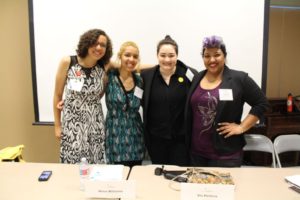I am in my senior year of college, and I am double majoring in social work and English. Now, originally, I was double majoring in sociology and English. However, because I wanted to work with people face-to-face, and not study people from a distance, I switched to social work. Because that department focuses so much on empathizing with a variety of people of hyphenated identities, as a mixed race person, I grew to love my department right away!
In my major, I have done research on policy that has affected mixed race populations, and I am doing research with other awesome social work students in transracial adoption. Having the freedom to do research and interventions on our passions and passions we never knew could develop is a delightful freedom to have.
The most important thing for me, personally, that the social work department emphasizes, as any serving department emphasizes, is cultural competency. Cultural competency is being able to work cross culturally with other individuals and groups. Being able to acknowledge the culture you come from, while also knowing the best tools and the best way to be intentional for people of a culture, or cultures, you are outside of.
In the majority of my textbooks on social work, there are chapters that emphasize how to work best with certain racial populations, and what you need to know about them. However, I’ve noticed that as each of the authors go through each group, interracial families are either barely touched on or not touched on at all.
There isn’t enough research done, or interracial families are touched on in one example case study out of the many case studies the authors present to the reader.
Moreover, when discussing transracial families, the Indian Child Welfare Act is briefly touched on, or the process for kids transitioning from being a foster child to an adopted child. However, there still isn’t enough research done on what transracial families are like, or, how to best work with transracial families. Especially when there has been debate on whether or not parents should adopt children of a race(s) that isn’t their own (Smith, Jacobson, Juárez 2011).
A problem I have with this lack of attention and lack of research is that it perpetuates the idea that interracial and transracial families are exotic rarities when they are anything but.
Another problem I have with this is that it perpetuates a particular binary when it comes to doing research in diverse populations.
Social workers have to compare monoracial white people and monoracial people of color (yes, the phrase “people of color” to group so many people in one category marks my last statement as a binary). Social workers have to compare straight people and the LGBTQIA community (again, grouping various people together into one still perpetuates a binary). This list can go on and on into class, religion, etc.
There’s not enough middle ground. There’s not enough of a spectrum present. And more and more people ought to know by know how wide the spectrum is when it comes to interracial families having mixed race children, transracial families in regards to the background(s) of the children that are a part of their unit.
When I presented my policy research last year, people were shocked to find that there are no policies that are enacted to protect and provide benefits to various mixed race communities in the same way that there are for various monoracial communities (Campbell & Herman 2010). And even in that, it can be difficult to present, because if I want to be a social worker, how helpful am I going to be by using a monoracial verses multiracial binary? Whether it’s individuals or families?
One positive that can come out of this process of figuring this out, for me, personally, is to advocate for more of that research to be done, if not do it myself, as a mixed race person.
There needs to be more of us in the social work field.
There needs to be more of us researching policy to see how mixed race populations are affected by certain policies.
There needs to be more of us making sure the cultural competency in our backgrounds and other people’s backgrounds is done much better than it has been.







